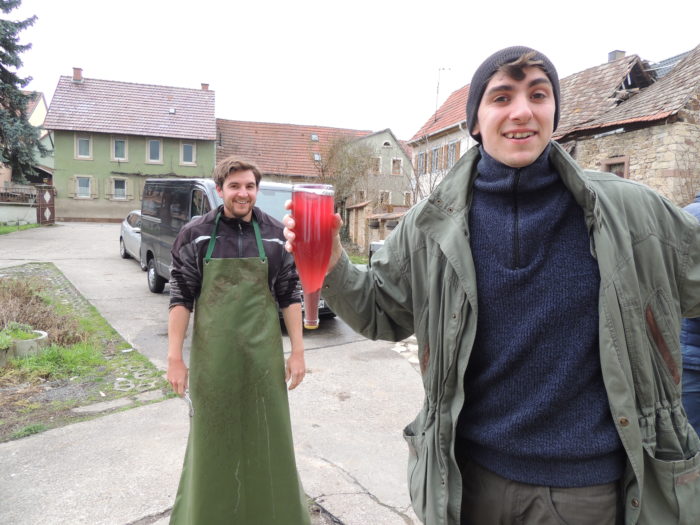
The cool climate of the northern Pfalz, and the organic, bio-D, natural ferment hocus-pocus of the brothers Brand, all come together to craft one of the most fascinatingly delicate, ultra-light pet-nats on the face of the earth.
The response last year was, well, psychotic. We hope for nothing less this year as the wines have achieved even more clarity, and have gained in reputation. Allocations may be tighter because when we visited the Brands in March John went on a bender and basically drank half the quantities in the pet-nat party wagon (pictured below).
Two bottlings are on offer today: a white and a rosé. The white is  half Silvaner and half Weißburgunder Pinot Blanc) and it clocks in at a mere 10% alcohol. It tastes like sea spray with bubbles, showing a fresh mineral core and unquestionable cut. The rosé is mostly Pinot Noir with 10% Portugieser; after an initial burst of round, tart, juicy red fruit it finishes dry, clean and mineral with great focus.
half Silvaner and half Weißburgunder Pinot Blanc) and it clocks in at a mere 10% alcohol. It tastes like sea spray with bubbles, showing a fresh mineral core and unquestionable cut. The rosé is mostly Pinot Noir with 10% Portugieser; after an initial burst of round, tart, juicy red fruit it finishes dry, clean and mineral with great focus.
Hit us up if you wanna taste any of the Brand brothers classic liter bottlings or 0-sulfur “Pur” wines.
But if you want any pet-nats, this is probably last call until June 2019 because the brothers are now minor rock stars and they barely even return our phone calls.
2017 Pet Nat WHITE: ~$30-$32
2017 Pet Nat ROSÉ: ~$30-$32
2017 Pet Nat WHITE MAGS: ~$72-$75
2017 Pet Nat ROSÉ MAGS: ~$72-$75
*all wines arrive early June*
Weingut Brand
The young brothers Daniel and Jonas Brand took over the family estate in 2011 and are part of a group in the Pfalz, Rheinhessen and Franken turning away from conventional farming and the sins of the 1960s and 70s. They are friends and colleagues with German winemakers Andreas Durst, Michael and Melanie of 2NaturKinder and Stefan Vetter and have looked beyond Germany as well for inspiration. Jonas just apprenticed at Domaine Jousset in Montlouis, as but one example. They have converted all of their vineyard work to organic and are certified by Bioland as of vintage 2017. They are also working biodynamically, all fermentations are natural-yeast and low levels of sulfur are used when possible.